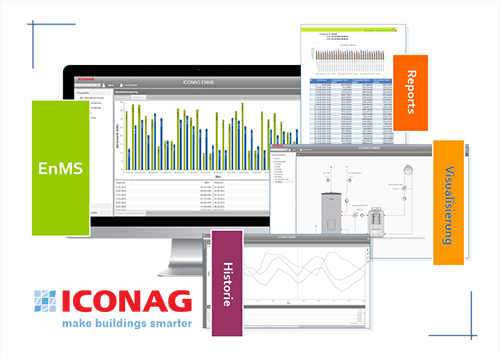am 03.09.2021 - 14:34 Uhr
The building automation market continues to grow steadily, and with it the number of suppliers in this sector. Whereas in the past the planning, execution and maintenance of building automation was left to just a few large standard companies, it is now increasingly common to plan and tender independently of manufacturers and to award the building automation trade to local plant engineers as system integrators.
To ensure interoperable and manufacturer-independent communication between the various trades, the American Society of Heating, Refrigerating and
Air-Conditioning Engineers (ASHRAE) developed a standardized network protocol.
BACnet (Building Automation and Control Networks) not only ensures interoperability between devices from different manufacturers, but also offers several advantages in the practical use of management and control equipment (BMS systems).
The most important difference to other protocols: BACnet is object-oriented. This means that a BACnet object contains all the information that belongs to the functionality of a data point.
While other protocols such as KNX or ModBus only specify the existing value (Present Value) as a data point, BACnet provides several additional pieces of information (so-called "properties") in a single object. For example, information on maximum values (High Limit), minimum values (Low Limit), alarm identification (Notify Type), change threshold (COV Increment) and many more.
While other protocols only provide the ACTUAL value as the only information, which then still has to be interpreted in the management and operating equipment, the management function of BACnet takes over the interpretation and evaluation of the information directly in the automation station. This avoids misinterpretations and saves valuable time.
All BACnet objects and information are stored and processed decentrally in the automation station. Since this also includes the execution of schedules or the generation of alarms, these are reliably executed even when the MBE system is offline. BACnet thus offers significantly increased operational reliability.
The objects and their properties can be easily read out from the network at any time using various tools. This means that all information is immediately available to the user and does not have to be requested from the programmers in a time-consuming process.
Since each BACnet object contains all information about the data point, including the description, it makes sense in the context of a BIM approach to select this description according to the asset identification system of the building automation system. Based on this approach, the operating and management functions required for a specific project can be implemented with significantly reduced effort. In B-CON, for example, operating elements (controls) are available for all relevant BACnet objects.
The integrated schedule management allows the simple administration of time schedules in the automation systems as well as the configuration of the time switch. Trends are not simply displayed, but recorded, created in the trend management and archived for a long time.
BACnet is currently the ideal protocol at the management level (MBE / GLT) and offers numerous advantages in practical use for building owners, investors, planners and building operators. However, there are also some important things to consider. Since the use of BACnet involves a shift of intelligence from the MBE to the automation station, somewhat
more planning and significantly more specifications and definitions are required in advance.

By networking the individual meters of a building, a modern building management system with integrated energy management system such as B-CON not only allows central recording and monitoring, but also the performance of various analyses in a single system.
For example, several properties can be compared directly with each other or evaluated on a seasonally weather-adjusted basis. An integrated tool supports with a top-down analysis the quick identification of weak points such as open fresh air dampers or the fast detection of leakages or incorrectly adjusted systems.
In this way, energy-relevant factors in building operation such as temperature specifications, system parameters, operating times, window and door positions as well as major energy consumers can be monitored, controlled and corrected directly via the system using a uniform user interface (browser-based).
"The goal is maximum transparency of system statuses and malfunction statistics," says Daniel Rörich, Technical Sales at ICONAG-Leittechnik GmbH. "Only through the permanent collection and consolidation of all data can effective measures be derived quickly if necessary and more efficient energy management implemented."
However, the monetary and energy-related savings potential is not the only benefit that results from the use of an integrated energy management system (EnMS). It has a positive impact on the operator's image and helps meet investor specifications, such as complying with energy efficiency classes or achieving LEED certification from the U.S. Green Building Council.
From a marketing point of view, there are also clearly measurable advantages to such a system, for example in terms of the indoor climate in retail stores, shopping malls and hypermarkets.
It is no longer a secret that a pleasant indoor climate has a direct and positive effect on merchandise sales. If this is achieved with optimal energy use, the return on investment improves.
In addition to retail, other industries benefit from the introduction of an energy management system integrated into the building management system (BMS). Manufacturing companies strengthen their competitiveness and, under certain conditions, can benefit from subsidies and tax breaks.
In data centers, the use of such a system is particularly interesting. High energy costs are incurred through operation and cooling, and failures in building technology often go hand in hand with risks to operations.
Regardless of the industry and the building, the greatest benefit of an energy management system (EnMS) integrated into the building control system lies in the permanent and cross-property recording and evaluation of consumption data, as well as the rapid detection of errors and the resulting gain in time for taking derivative action.
Only if this integration is guaranteed can cost reduction potentials be reliably revealed and measures to increase efficiency and optimize building operation be taken immediately. Measurable benefits from which more and more building operators are profiting.
Powered by ModuleStudio 1.3.2